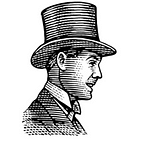“One of the things I like about jazz, kid, is I don’t know what’s going to happen next. Do you?”
— Bix Beiderbecke
Music is perhaps the best way to convey the essence of the Roaring Twenties, a time that, in symphonic terms, was the fortissimo of American musical history. Never before had music been played quite so loudly, with so much bravado, or with so much unpredictability — much like American life itself after the Great War.
Black music and culture bled into the zeitgeist more than ever before, as words such as “jazz” and “blues” became part of the lexicon. While Babe Ruth outpaced his own records, Louis Armstrong began releasing his own, becoming America’s first true pop star in the process. Then in the winter of 1927 a man named Edward “Duke” Kennedy Ellington started broadcasting live from the Cotton Club to radios across the country, bringing audiences to the forefront of musical innovation.
Also in the twenties, Bessie Smith became the first black woman to achieve widespread musical fame across the globe. Bessie sang the blues — songs about struggle, pain and love in a musical tradition that evolved from plantation work songs. Smith not only popularized the blues — to the point where the word “blues” was attached to almost every popular recording, whether it was the blues or not — she changed the way music was sung forever, introducing modern tones and phrasings.
These artists and their revolutionary musical styles also marked the beginning of the era of American musical “standards” — songs that would continue to play well beyond the ’20s as generations of future musicians adapted and interpreted them.
The American Dream
The story of almost all of the composers, singers and entertainers of the Roaring Twenties was one of rags to riches. Their rise, and the themes of their songs, helped to solidify the American dream — a new world where a boy could rise from playing bugle on the streets of New Orleans, or from swatting a baseball in a Baltimore orphanage, to go on to captivate and inspire an entire nation.
Six miles south of Yankee Stadium, George and Ira Gershwin redefined musical theater while writing some of the first chapters of the Great American Songbook. Tacking on several chapters of his own, Irving Berlin rose to fame from a childhood haunted by Russian pogroms and life in the tenements of the Lower East Side. He composed the score for first feature-length film with sound, The Jazz Singer, which debuted in 1927, with Al Jolson singing “Blue Skies” for the first song performed and heard on cinema screens.
The Soundtrack of the Roaring Twenties
Thanks to jazz and blues, record sales exploded in the 1920s, with hit recordings selling more than two million copies apiece.
With the advent of radio, both baseball and music became part of the constant stream of entertainment seemingly overnight, coming out of speakers in living rooms and bedrooms across the country.
Much as the iPod, iPhone and streaming service like Spotify have changed the way we listen to music, in the 1920s radio suddenly made it possible for the live sounds of baseball and the music of the Jazz Age to flood homes and apartments across America with the simple flip of a switch.
Like Rock ‘n Roll and the 1960s
Jazz in the 1920s captivated young Americans in the same life-altering ways that rock ‘n roll would affect the world in the 1960s. It literally turned the nation on its ear.
It was not unusual for a young man to hear a jazz band for the first time, ask where they were from and where they were going next, and then just leave home to join or follow them. And the music and lyrics of jazz and blues were as sexually liberating to young women and men, alike, as rock ‘n roll would be four decades later.
The Roaring 20’s
Jazz and baseball in the Roaring Twenties were twin catalysts for the rise of celebrity culture — the ability for one person to take center stage, whether under a spotlight or in the batter’s box. Technological innovations allowed the ripples of cultural change to travel faster and reach farther than ever before, making overnight stardom a new possibility.
While listening to our Spotify selections, keep in mind how new these styles of music were. You will be listening to some of the nascent recordings of jazz and the blues, two styles that conveyed a sense of freedom and expression never heard before in mainstream music.
Imagine being Myles Thomas, overlooking a mansion party on the Long Island Sound and hearing songs like these for the very first time in your life.
You don’t exactly know what to think, but the music carries a certain energy.
Just like baseball in the 1920’s, the music roars.
Listen to our playlist on Spotify.
